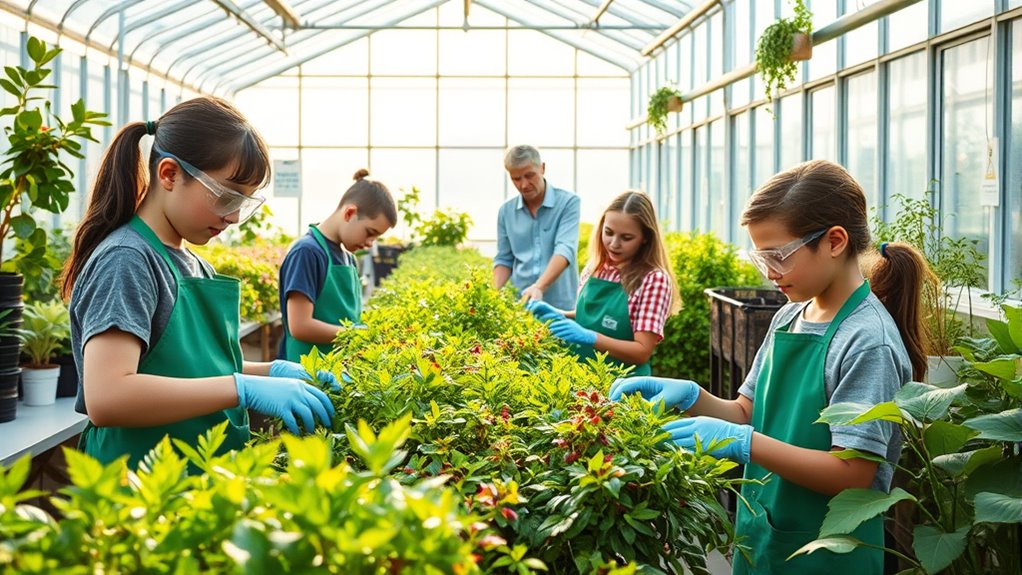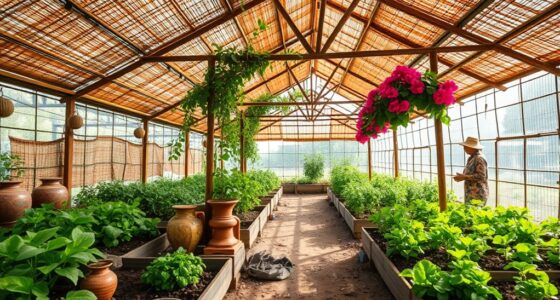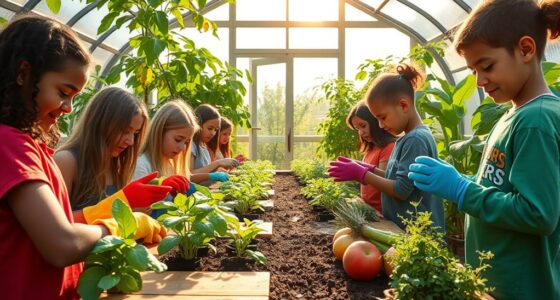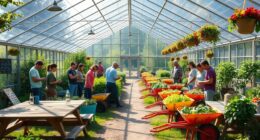To guarantee safety in your school greenhouse, regularly identify hazards like broken glass or exposed wiring and keep pathways clear of obstructions. Implement safety measures such as visible signage, accessible emergency equipment, and clear procedures for fires or spills. Train staff and students on hazard recognition and safety protocols, emphasizing proper handling of tools and protective gear. Consistently review and update safety plans to create a secure environment. Exploring further will help you develop a thorough safety plan tailored to your greenhouse.
Key Takeaways
- Conduct regular hazard assessments to identify and address risks like broken glass, exposed wiring, and unstable shelving.
- Implement clear safety signage, unobstructed pathways, and accessible emergency equipment throughout the greenhouse.
- Develop and routinely practice emergency response plans for incidents such as fires, spills, or injuries.
- Educate staff and students on hazard recognition, safe tool handling, and proper use of protective gear.
- Review and update safety protocols regularly to adapt to new hazards and ensure a safety-first environment.

Greenhouses are valuable educational tools, but they also pose potential safety risks if proper protocols aren’t followed. As someone responsible for maintaining a safe environment, you need to understand how hazard identification plays a pivotal role in preventing accidents. Before anyone steps into the greenhouse, you should carefully inspect the space for potential dangers. Look for broken glass, exposed wiring, or unstable shelving that could cause injuries. Check that all equipment, such as heating systems, fans, and irrigation tools, are in good working condition. Identifying these hazards early allows you to address them promptly, reducing the risk of injury or equipment failure.
Once hazards are identified, you can implement appropriate safety measures. Make sure pathways are clear of obstructions and that safety signage is visible. This helps both staff and students recognize hazards and navigate safely. It’s essential to establish clear emergency procedures in case something goes wrong. Everyone should know what to do if a fire occurs, if there’s a chemical spill, or if someone gets injured. Regular drills help reinforce these procedures, so responses become instinctive during an actual emergency. Keep emergency equipment, like fire extinguishers, first aid kits, and eye wash stations, accessible and well-maintained. Ensure all staff and students are familiar with their locations and proper usage.
Implement clear emergency procedures and keep safety equipment accessible for a safer greenhouse environment.
Training is key to maintaining safety. Educate everyone on hazard recognition and promote a safety-first mindset. Teach students how to handle tools safely and emphasize the importance of following safety rules. When everyone understands the hazards, they can act proactively to avoid accidents. For example, instruct students on safe handling of plants and chemicals, and remind them to wear protective gear when necessary, such as gloves or goggles. Consistent supervision and enforcement of safety policies are essential in maintaining a secure environment. Additionally, understanding the importance of special occasions like safety drills or safety awareness days can enhance overall preparedness and foster a safety-conscious culture.
In addition, reviewing and updating safety protocols regularly helps adapt to new hazards or changes within the greenhouse. This ongoing process ensures your safety measures stay effective. When hazards are properly identified and emergency procedures are well-practiced, you create a safer space for learning and exploration. Remember, safety isn’t just about reacting to emergencies—it’s about preventing them through vigilance, training, and proactive planning. By prioritizing hazard identification and being prepared with clear emergency procedures, you protect everyone who steps into the greenhouse, making it a productive and safe environment for all.
Frequently Asked Questions
Are There Specific Safety Certifications Required for Greenhouse Equipment?
You should check certification requirements for greenhouse equipment to guarantee safety and compliance. Many equipment standards are mandated by local or national agencies, like OSHA or ANSI, which set the necessary certifications. Properly certified equipment helps prevent accidents and ensures safe operation. Always verify that tools, heating systems, and electrical components meet these standards before use. Staying compliant with certification requirements protects everyone and maintains a safe greenhouse environment.
How Often Should Safety Drills Be Conducted in the Greenhouse?
You should conduct safety drills in the greenhouse at least twice a year to guarantee everyone knows evacuation procedures and how to use emergency equipment properly. Regular drills help identify gaps in safety protocols and keep staff prepared for potential emergencies. During these drills, focus on clear communication, quick response times, and practicing the correct use of fire extinguishers, first aid kits, and other emergency tools to maintain a safe environment.
What Are the Procedures for Reporting Safety Hazards?
You should promptly report safety hazards by following your school’s hazard reporting procedures, which typically involve notifying a staff member or filling out a hazard report form. Clearly describe the safety hazard, including location and potential risks. Always document the issue if possible. By adhering to safety hazard procedures, you help guarantee the greenhouse remains a safe environment for everyone, and hazards are addressed quickly to prevent accidents.
How Is Student Supervision Managed During Greenhouse Activities?
During greenhouse activities, you should follow supervision protocols by maintaining constant student safety monitoring. You keep students engaged and make certain they follow safety rules, such as wearing protective gear and handling tools properly. You assign specific supervisors to different groups, making sure everyone stays within their designated areas. By actively supervising and monitoring student behavior, you create a safe environment that minimizes hazards and promotes responsible greenhouse participation.
Are There Age Restrictions for Students Working in the Greenhouse?
You should follow your school’s greenhouse safety policies regarding student age restrictions. Typically, younger students might be limited from certain tasks due to safety concerns, while older students can handle more complex activities under supervision. These policies help guarantee safety and proper supervision. Always check your school’s specific guidelines, as age restrictions are in place to protect students and promote safe, responsible greenhouse work.
Conclusion
By following these safety protocols, you protect both yourself and your students, creating a secure environment where growth and learning can flourish. Remember, a safe greenhouse isn’t just about rules—it’s about nurturing confidence and trust. Think of safety as the sturdy foundation beneath every thriving plant; without it, even the strongest growth can falter. Embrace these practices wholeheartedly, and watch your greenhouse become a sanctuary of discovery and safety for everyone involved.









